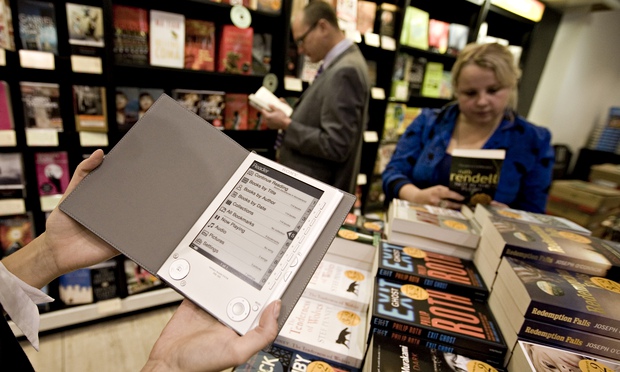
24 Abr Las ventas de libros impresos caen más de 150 millones de libras en los últimos 5 años [en inglés]
Las ventas de impresos de ficción para adultos han disminuido en más de £ 150 millones desde 2009. Las nuevas cifras muestran cómo los libros electrónicos toman cada vez más el mercado.
A review of 2014 from book sales monitor Nielsen BookScan shows that while the decline in sales of print books in the UK slowed last year, with value sales down 1.3% to £1.39bn, and volume sales down 1.9% to 180m, the performance for printed adult fiction was markedly worse. The adult fiction market was the worst-performing of all areas of the book business, down by 5.3% in 2014 to £321.3m, with volume sales down 7.8% to 50.7m. In 2009, printed adult fiction was worth £476.16m.
The decline is even greater when paperback fiction is removed from the picture: according to Nielsen, hardback adult fiction sales plummeted last year by 11.6% to £67.9m, with just three titles – by crime and thriller bestsellers Lee Child, CJ Sansom and Martina Cole – selling more than 100,000 copies.
“The ebook has quite demonstrably hit the commercial end of the fiction market,” said the Bookseller’s editor Philip Jones. “Almost any drop in adult fiction sales can mainly be put down to the migration to digital, which is obviously still continuing. We think consumer ebooks this year will be worth £350m, with most big publishers reporting ebook growth of double digits – and almost all of that will be in fiction.”
At Nielsen, research director Andre Breedt said that although the company does not yet have full-year ebook data, “data to September does indicate that decline in fiction is really more migration to ebooks rather than real decline”.
Within adult fiction, there was growth for three unexpected categories: short stories, westerns and graphic novels.
The picture was less pretty for general and literary fiction sales, however, which fell year-on-year, as did sales for the crime and thriller genre, science fiction, fantasy and horror, historical, war, erotic and romantic genres, according to Nielsen.
“I think that what we are seeing is booksellers becoming much more sensible about what they put on their shelves,” said Jones. “Obviously if you can’t sell 20,000 copies of a commercial fiction title, you need to put something else out there, so we’re seeing all over that areas of the market such as graphic novels are getting more shelf space, as booksellers learn what readers want to buy in print. I think that in the future, we may see even more neglected areas of the market came more into the centre.”
Advertisement
High-end literary fiction, said Jones, continues to sell in print, with titles such as The Miniaturist and Elizabeth is Missing performing well in both paperback and hardback. Nielsen’s chart of 2014 is topped by John Green’s young adult title The Fault in Our Stars, which sold 633,919 copies, making over £3.4m in revenue. The first adult novel to enter 2014’s chart is Gillian Flynn’s psychological thriller Gone Girl, with sales of 366,364 copies putting it in ninth place. Dan Brown’s conspiracy thriller Inferno is 10th, with 347,704 copies sold to the value of £1.6m, Kate Atkinson’s literary hit Life After Life is 12th (298,000 copies sold), Donna Tartt’s The Goldfinch 14th (267,000 copies sold), Khaled Hosseini’s And The Mountains Echoed 18th (235,000), Helen Fielding’s new Bridget Jones novel 19th (232,000) and Graeme Simsion’s The Rosie Project 20th (231,000).
Adult non-fiction also saw a decline in print sales last year, down 4% to £585.7m, reported Nielsen BookScan. The sector is down 21% compared to 2009, when sales were worth £738.4m.
But there was a bright spot for children’s books in 2014, where sales rose 9.1% to £336m, with picture books up by 8.7%, and children’s and young adult non-fiction increasing in value by 35.8% to £44.5m. The average selling price for printed books was £7.74 last year, 4p more than in 2013, said Nielsen.
The strong performance for children’s books, said Jones, was a good example of the trend for booksellers replacing adult fiction on their shelves with better-performing print areas. “If commercial fiction is going to digital, booksellers will put lots of children’s books out there, because parents are still buying children’s books in print.”
